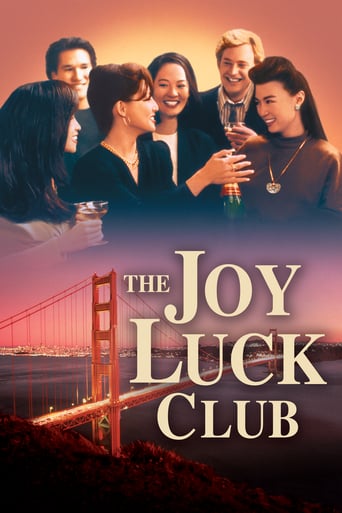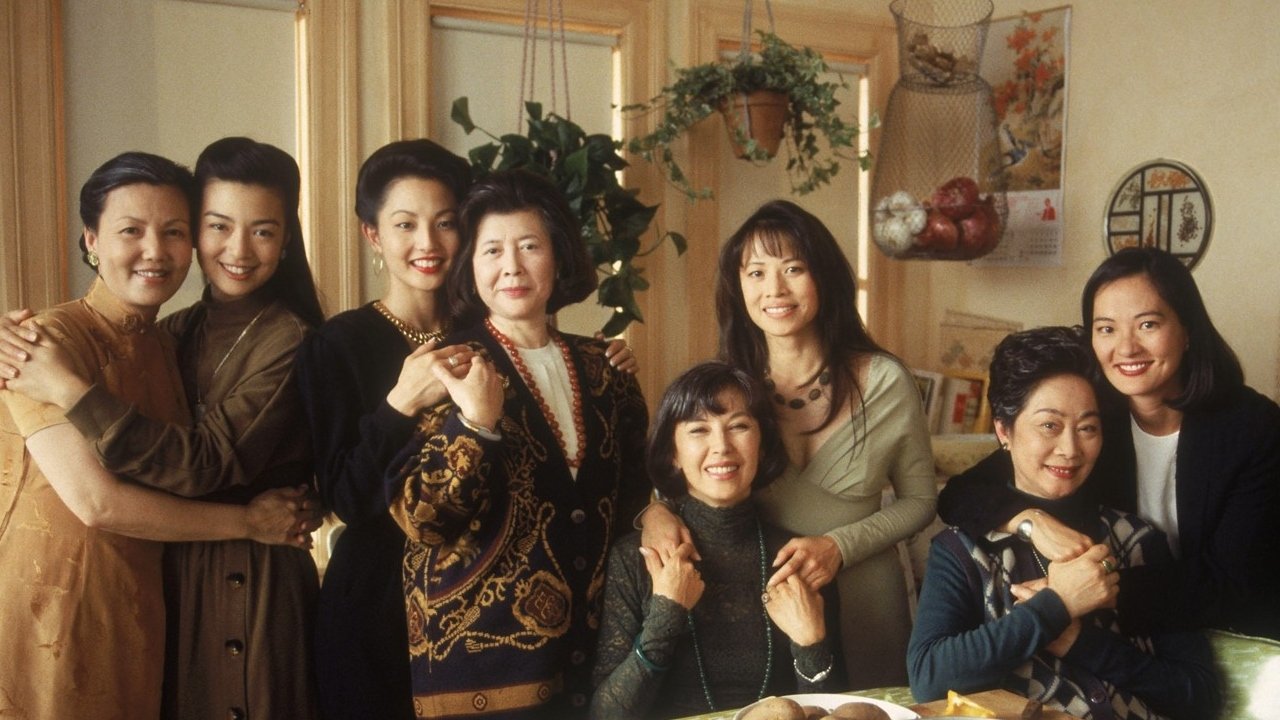Victor Kim
The Joy Luck Club should be condemned, not praised!! These women are sell outs!! First of all, why is the film only about the women? What about the Asian men? There isn't a single leading Asian male character! This film portrays marriage to an Asian man so negatively, while the rich white husbands are portrayed so positively. This is shocking because the Asian men I know are not like this at all. They are much more caring, strong and masculine than this. In fact, I have heard of many white husbands in the news who get drunk and beat or even kill their Asian wives. The Asian men I know are worthy candidates for marriage and are never aggressive toward women.These Asian mothers toiled through sweat, tears and blood, surviving a brutal war to come to America. And what do their daughters do in return? They forget all the hardship their mothers endured and marry the first rich white man they meet!! Instead of working hard for their money like their mothers, they want to be pampered by their rich white husbands and live an easy life of luxury through marriage! These women basically sell their bodies, beautifying themselves according to Western standards of beauty, while trying to sound educated so they can enter upper class society. They basically use their sexuality as a tool to move upward in social class through marriage. This, my friends, is a form of PROSTITUTION!! Whether these women are doing this consciously or subconsciously, they are engaging in prostitution. Is that really all an Asian woman has to offer society?This is an absolute disgrace and an incredible insult to all the real, hard working Asian-Americans in the United States, many who struggle in poverty and have no real voice in society. Any dignified Asian woman should realize that this film is Westernized propaganda, teaching Asian- Americans that white is better, that Asian men are terrible lovers, and to look the other way as their heritage gradually erodes. Tell me, how many objects of Asian cultural heritage can you find in the homes of their white husbands, even after marrying their Asian wives? Can you find even one painting or vase?This film teaches Asian women to scorn their Asian men, even their own fathers, and to learn to "put up" with their mothers, who are an "obstacle" to be dealt with. This film does not empower Asian-Americans. Instead, this film brainwashes them to gradually despise themselves as they develop a crippling inferiority complex and a bitter sense of self- hatred. To make matters worse, The Joy Luck Club portrays the so-called "Asian-American experience" solely through the voices of women, while completely ignoring the male experience. This film is damaging and should be viewed as a negative scar that Asian-Americans must move away from.
jzappa
The story comes after a death and a reunion that bring the past back in all of its undiluted passion, and shows how the present, too, is made, how children who think they are worlds apart are inextricably influenced by the lives of their parents. Wayne Wang's touching film, based on Amy Tan's novel, is about four women, who were born in China and later came to America, and their daughters. Among these eight women mingle countless friends and relatives, to the mise-en-scene's maximum scenery capacity, in peripheral branches of life. Actually, those scenes are the biggest weaknesses of the film, as their interjecting party jest is so transparently scripted that we want only the bottom line of the scenes. But what is about to be dissolved are the beginnings of the women, the stories of how they were born and grew up in a time and culture so far apart from the one in which they live now.The club of the title is a circle of elderly Chinese ladies who meet weekly to play mah jong, and trade stories of their families and grandchildren. All have made ruinous paths from pre- revolutionary China to the privileged homes in San Francisco where they meet. But those old days are not frequently talked about, and often the entire reality of them is not revealed.In a framework of flashbacks, the secrets and stories of all four of the "aunties" are unraveled. We see that the China of the 1930s and 1940s, before the Revolution, was an inconceivably dissimilar world than it is today. Women were not considered too much. Those with resilient spirits and wills were regarded even less than the impressionable, submissive ones. Life was worthless, no more than in wartime. A mother's ability to love her children was doubted. In plenty of instances, all-consuming dilemmas from those hard days still find their echoes in succeeding generations: The potent reality of Amy Tan's story is the lack of understanding between cultures that make the capability of the mothers to identify with their westernized daughters rely on things that have never been clearly vocalized.How, in one instance, could the narrator's mother have told of deserting her first-born twin girls by the roadside? Her mother, ill and emaciated, was certain she should die, and believed her girls would have a better likelihood of living if they were not compromised by the "bad luck" of a deceased mother. Other stories are just as, if not more, agonizing to Americanized ears. There is the auntie who becomes the fourth wife of a wealthy man, and when she gives birth to the son he wished for so much, the child is taken from her by the second wife.In America, the mothers find it difficult to get their minds around the paths their daughters are taking. Some marry whites, who have deplorable etiquette. They move out of the old neighborhood into houses that seem too cutting-edge and frigid. One daughter gives up on ever pleasing her mother, who carps on everything she does.This movie was produced by Oliver Stone, who himself at one time was an astute and scrappy filmmaker who turned out films with cross-cultural themes like this one, such as his Vietnam trilogy, and Joy Luck's director Wang leaves us longing for the rawness of those films, but he captures Tan's story and keeps it pure within his medium. Her story is as respects Chinese and Chinese-American characters, but their stories are all-inclusive. Anyone, everyone, can relate to how the expectations of one generation can become both the obstructions and the awakenings of the next.
ccthemovieman-1
On my first viewing, this film got a "fair" rating because there were not enough memorable roles and the story was confusing to me. I lost track of which person was telling their particular story at the moment. (There are eight stories woven into this two hour, 19 minute movie). I think it would be confusing to most one-time viewers to get confused here if you don't know the stories or the actors. It also got a little soap-opera-ish, too, but then again, this film was based on a best-selling book that was ready primarily by women.On the second viewing, almost two years later, I liked it a lot more and upgraded my "star" rating considerably. It's still a "chick flick" and a feminist one. The young women are that way, the Americanized women, while their mothers, those all born in China, are quite. The older ladies are a bit too strict and their daughters are a bit too liberal. That included general morals and language - a big difference between the two generations and cultures. The feminist angle I didn't like was that in almost every relationship the man is painted as the bad guy (the abuser, the non-loving type, etc.) That kind of story bias was too much.The more memorable of the stories turned out to be the ones with the older women, such as the one who left her two babies at the base of a tree, or the one who had to marry a young boy.For me, the best part of the film was the cinematography. There were some beautiful scenes and great colors: bright oranges, yellows, reds and browns. Some of the young women were beautiful, too. The lady narrating in the beginning, "June" (Melanie Chang as a nine-year- old and then Ming-Na as an adult) was very appealing and had a great voice. Her story is the one that begins and ends the film. That ending, by the way, is almost guaranteed to bring a few tears.Overall, a wonderful visual movie and a great venue for Chinese-American actresses, all of whom I found fascinating to watch.
springgarden2004
This film entwines the lives of women and their daughters with masterful expertise. The storyline is profound. The casting and acting is superb. Cinematography and direction are also astounding and capture the lives of these women with realism and compassion. This is my all-time favorite film. It is an emotionally wrenching story in many ways but as story that is relevant to the multi-cultural world we live in. There are complex layers of meaning and social commentary here. We see inside of marriage, family, and traditions that have crossed oceans as well as invisible boundary lines. It handles these sensitive issues deftly yet with implicit insistence that we take notice. It is a film to be treasured.



 AD
AD




